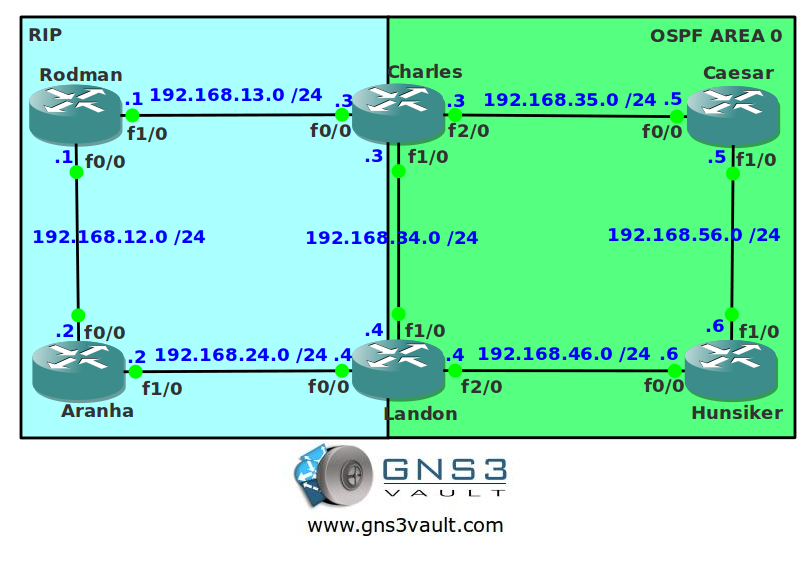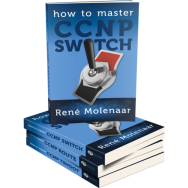Scenario
A famous research company is trying to develop a medicine to increase the capabilities of the brain. They are trying to connect their site to another research center to exchange information but there is some trouble with the redistribution of routing protocols. You as a senior network engineer are able to solve this problem without too much trouble..or do you? Let’s see!
Goal:
- All IP addresses have been preconfigured for you as specified in the topology picture.
- Each router has a loopback0 interface.
- Configure EIGRP AS 1 on router Charles, Caesar, Landon and Hunsiker.
- Configure RIP Version 2 on router Rodman, Aranha, Landon and Charles.
- Configured two-way redistribution on router Charles and Landon.
- Achieve full connectivity so you can ping all physical and loopback interfaces.
It took me 1000s of hours reading books and doing labs, making mistakes over and over again until I mastered all the routing protocols for CCNP.
Would you like to be a master of routing too? In a short time without having to read 900 page books or google the answers to your questions and browsing through forums?
I collected all my knowledge and created a single ebook for you that has everything you need to know to become a master of routing.
You will learn all the secrets about redistribution between RIP and EIGRP and more.
Does this sound interesting to you? Take a look here and let me show you how to Master CCNP ROUTE
IOS:
c3640-jk9s-mz.124-16.bin
Topology:

Video Solution:
Configuration Files
You need to register to download the GNS3 topology file. (Registration is free!)Once you are logged in you will find the configuration files right here.

The How to Master series helps you to understand complex topics like spanning-tree, VLANs, trunks, OSPF, EIGRP, BGP and more.
Written by René Molenaar - CCIE #41726


Hi, Rene!
Very bright way to prevent redistribute prefixes back to IGP… Its like router marks a prefix and dont accept it back!
Great!
Thank you.
Thanks Kenia 🙂
after i download the cfg how do i attach it to my GNS
BTW : great site.
In the first ZIP file you’ll find the TOPOLOGY.NET file that you can open in GNS3. The .CFG (config) files will be opened automatically or you can import them manually into your GNS3 routers. You can just copy/paste them or use the "import" button in the toolbar of GNS3.
Hello. I see in the topology file OSPF AREA 0. I assume you meant EIGRP, right?
Yes I mean EIGRP…i’ll fix this one 😉
Hi Rene
My final configs are not the same as yours, but I do manage to achieve full reachability after redistribution.
Is there any chance of you taking a look at my configs and letting me know what you think?
Thanks in advance!
Hi Phr0zen,
That’s possible. There are multiple methods to deal with redistribution issues. I don’t mind looking at the configs but could you create a forum post for this? It’s easier than using the comment system.
Rene
Best networking site so far. well done Renee
Hi Rene
I saw in your final configuration, that you used tags with redistribution. But is it give any profits in this particular lab scenario?
Keeping in mind that:
RIP internal 120 is less then EIGRP ext 170
EIGRP internal 90 is less then RIP ext 120.
So domain loop issue, should not occur in this scenario, right?
Rene, could you explain me for here, you said it in the video when you configuring:
[i]route-map TAGME deny 10
match tag 10
route-map TAGME permit 20
set tag 10
[/i]
I would greatly appreciate it.
The final configs still produce loops for Charles and Landon. I thought there was a problem with tagging but I then checked the config after configuring the protocols but before redistribution and still saw the loops.
After applying the final configs I still see the loops like this :
Landon#trace 5.5.5.5
Type escape sequence to abort.
Tracing the route to 5.5.5.5
1 192.168.46.6 20 msec
192.168.34.3 24 msec
192.168.46.6 16 msec
2 192.168.35.5 28 msec
192.168.56.5 40 msec *
Charles#trace 6.6.6.6
Type escape sequence to abort.
Tracing the route to 6.6.6.6
1 192.168.35.5 32 msec
192.168.34.4 16 msec
192.168.35.5 8 msec
2 192.168.46.6 32 msec
192.168.56.6 24 msec *
It seems the issue is that the destination to the loopbacks on the EIGRP side is known via both interfaces connected to EIGRP 1.
Charles :
6.0.0.0/24 is subnetted, 1 subnets
D 6.6.6.0 [90/158720] via 192.168.35.5, 00 : 0 6:22, FastEthernet2/0
[90/158720] via 192.168.34.4, 00 : 06:22, FastEthernet1/0
Landon : D 5.5.5.0 [90/158720] via 192.168.46.6, 00 . 09 : 04, FastEthernet2/0
[90/158720] via 192.168.34.3, 00 : 09 04, FastEthernet1/0
Is there any way around this and is it really an issue given traffic passing through the routers seem unaffected, e.g rodman can ping .5 and .6 with no loop? I was thinking something along the lines of applying routing policy to the interfaces but not sure how that works for a trace route ran directly on the router seeing as they affect traffic going into an interface?
What’s also confusing me is if its due to EIGRP then why don’t we see 2 paths for .5 and .6 on both central routers?
Rene, I don’t see an option to download the topology 🙁
I think it’s no nesessary to apply route-map on redistribution here, Charles and Landon’s route tables are all optimal default ,no domain loop occurs here.
I was wondering if it would be a valid design to have one border router do rip to eigrp and the other doing a eigrp to rip single point on-way redistribution on each. Would that not also prevent the routing loops? I know thats not what the lab asked for just wondered if it was a good design?
Thanks!
Mike,
That prevents a routing loop but their will be a single point of failure between between the routing protocol RIP and EIGRP, and it also introduces sub-optimal routes.